Ethernet RJ-45 cables shootout
And on the seventh day God ended his work which he had made; and he rested on the seventh day from all his work which he had made. But in the afternoon he became restless for he saw that some improvements are necessary for Ethernet cables to satisfy humans.
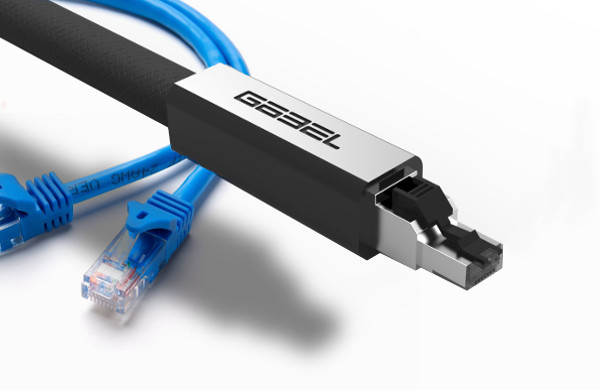
Categories for Ethernet (RJ-45) cables
The categories (CATs) are numbered according to TIA (Telecommunications Industries Association) standards. The higher the number the higher the transmission speed and capacity should be. The Ethernet cables below Cat5 are not recommended for demanding installations anymore as they have limited bandwidth in the order of 100Mbps/100MHz. Cat5 Cat6 and Cat7 are shielded and tested to gigabit specifications with extended bandwidth, the higher we move the higher the theoretical capacity should go, up to the claimed 10Gbps/600Mhz transmission.
I am not going to discuss why and how much this categorization may be correlated with what we heard during listening sessions for there are apparently more factors in the game: a method and quality of shielding, connecting pieces that were used, conductor material, lengths and many more.
This review does not have any educational aspirations either. Simply put, I am not going to explain why there are or they are not any audible differences between Ethernet cables – not because I do not want to just because I do not see any reliable technical justification behind different theories. Bits are bits and the Ethernet cables carry IP packets that are checked for errors by the transmission protocol. The data in packets are either received in full or they are not received, there is nothing like a ‘standard bit’ and an ‘audiophile quality bit’.
LVDS connections
It is becoming a common practice in audio to use RJ-45 or HDMI cables also for “digital” transfer between digital signal processing components, usually a CD/SACD transport, D/A converter and DSP processor. In fact these transfers are just emulation of digital up to 24bit/192kHz and use low voltage differential signaling (LVDS). LVDS is a Sony protocol that transmits information as the difference between the voltages on a pair of wires. The two wire voltages are compared at the receiver, the polarity of this voltage determines the logic level. Because of the equal and opposite current flow in the coupled wires of a cable the EMI should be cancelled out in theory as opposite electromagnetic fields are generated. The susceptibility to the EMI will largely depend on the design of the cable and for the transmission is voltage, hence analog, it was not surprising that we have found intriguing sound differences between the cables in the test.
Shopping for high-end patch cables
Audiophiles would never accept a subpar thin cable in a grey plastic jacket that everyone uses for internet connection. That is why all meaningful manufacturers have launched “audiophile grade” LAN cables to meet the market needs. Apart from those that we used in our test there are other attractive looking – and possibly attractive sounding – patch cables out there: Denon AK-DL1, Furutech LAN-10G, QED Ethernet Graphite, Goebel Lacorde, Synergistic Research Atmosphere X Reference, Cardas Clear Ethernet, Nordost Heimdall 2, Ayon Pearl and Stealth Audio I2S to name a few. This brings me to the list of the reviewed cables.
In the alphabetic order:
AudioQuest Vodka Cat7 Ethernet cable (325€/m) uses solid 10% silver conductors insulated by polyethylene and encapsulated in braided deep blue PVC jacket. The Vodka is said to be directional which is indicated by arrows pointing from the source to the receiving component. The cable is quite stiff and thick; its connectors are heavy metal pieces that lock with loud ‘click’.
The Vodka utilizes what AudioQuest calls Noise-Dissipation System (NDS): Traditional shield systems typically absorb and then drain noise/RF energy to component ground, modulating and distorting the critical "reference" ground plane, which in turn causes a distortion of the signal. NDS's alternating layers of metal and carbon-loaded synthetics "shield the shield," absorbing and reflecting most of this noise/RF energy before it reaches the layer attached to ground.
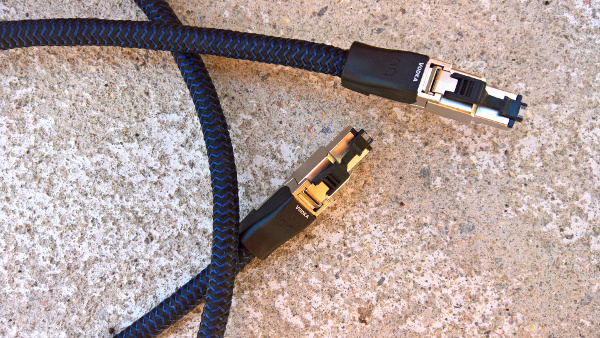
InAkustik Cat6 Ethernet Netzwerkabel’s (7€/m) silver and sky-blue PVC braid ends in rather standard RJ-45 connectors and offers dual shielding that is achieved by the braiding its 4 pairs of separate conductors as well as by a shielding foil.
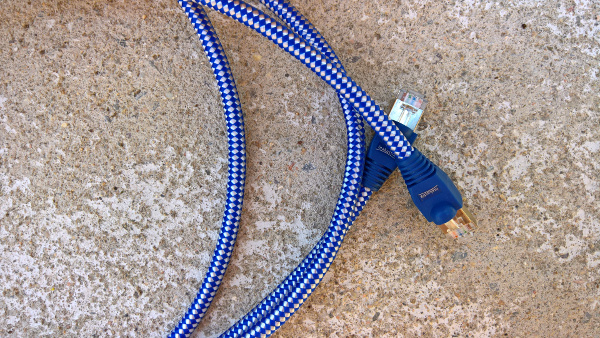
Neyton’s Cat7+ Ethernet Cable (20€/m) comes in a distinctive yellow jacket. Other than that it looks pretty standard. It is very surprising that the print on the cable allows you to identify the origin of the cable – it is actually LEONI MegaLine F10-120 S/F flex cable that is widely available over the internet by meters and that uses 4 pairs of twisted copper strands insulated in PE and shielded by polyester/aluminum tape. Considering that it is basically an off-the-shelf cable it was actually a surprise how good it performed in our test.
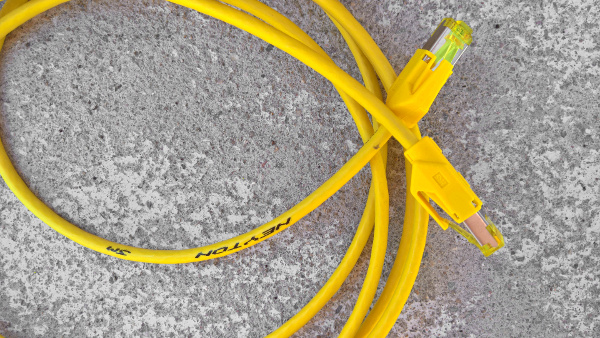
The off-the-shelf ‘SE Good quality’ Cat5 patch cable that I used in this test is a supermarket stock item that costs almost nothing (0.7€/m). You know, the grey flexible stuff that is around the house everywhere where internet is – throughout this review I will use OTSC (off-the-shelf cable) denomination for this cable.
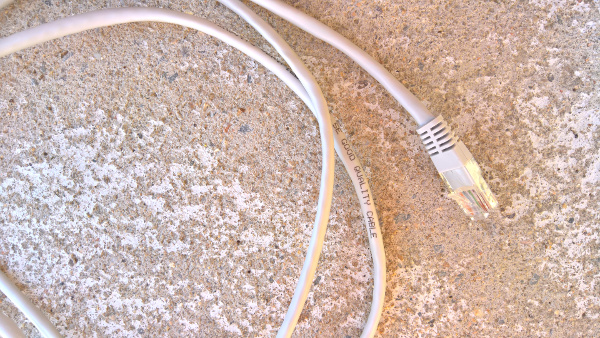
Supra Cat8 Ethernet Cable (42€/m) is a sort of understated elegance look in its pale blue sky PVC jacket. It uses OFC strands in polyethylene insulation, each tinned copper strand double-shielded by aluminum tape. The plugs look like gold-plated but if so then the plating seems rather minimalistic. The Supra Cat8 was the only Cat8 cable in the test. Supra claims that this cable is “one step ahead” and provides “extreme performance up to 40Gpbs – naturally it set high expectations right from the start.
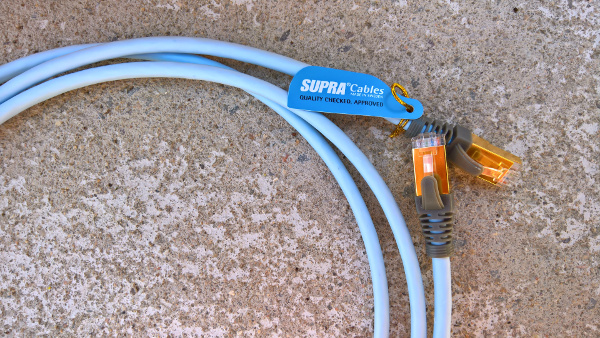
Viablue EP-7 CAT6A Network Cable (84€/m) is the most sexy-looking cable in the test. It has snake-skin pattern on its braid and really hi-tech connectors with unusual tactile feel thanks to an anti-slip polyamide layer. The build is exquisite and high-end: it uses silver-plated strands made of pure OFC copper and a total of 5 layers of shielding (braided shield and 4 aluminum foil shields); the connectors (T6s RJ-45 LAN plugs) are gold-plated and secured by crimping and hexagon socket screws.
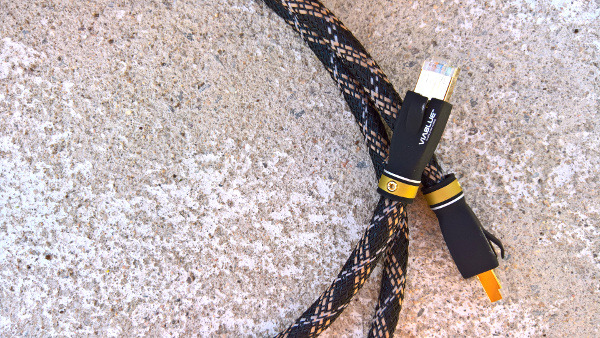
The music
To make the auditioning sessions simple and tidy only three albums were used throughout this review, ALAC files for streaming:
- Dire Straits, Brothers In Arms (Vertigo, 824 499-2)
An album that turned Dire Straits into rock stars, thanks to some technical finesse and the guitar sound that ushered a new era, the era of compact disc. The Brother in Arms album is the recording that ranks in Top 10 of any audiophile collection and it was reissued and remastered in many formats. For the review we used original Canada pressing from 1987 that happened to be just an old-fashioned transfer from the tape to CD without ‘remastering’ job.
- Nadége Rochat & Staatskapelle Weimar, Cello Abbey (Ars Produktion, ARS 38221)
Rochet says about spectacular Walton’s Concerto for violoncello piece that is included on the disc “I have attempted to insert my personality and creativity at the right moments in the score […] I wanted it to sound as if there were lyrics attached to it – including breathing, vowels and consonants.” No need to add that Nadége Rochat is a superb cellist who can make her instrument show its full tonal spectrum.
- Julia Roberts, S/T (Mercury Records, B0001902-02)
Prime example of Nashville sound, played and sung with passion and joy. Simple arrangements that are beautifully captured and mastered by Doug Sax and Robert Hadley at The Mastering Labs. Punchy drums, a resonant bass, fast transients of acoustic and electric guitars and smooth texture of Julia’s voice make this album a real audiophile treat.
Playing the cables: an HS-Link
The HS-Link connection is the LVDS protocol via Ethernet RJ-45 cable that Accuphase uses for communication between the DP-720 SACD transport and the external DG-58 DSP processor. This way the signal (PCM, DSD and DSD on PCM 176.4kHz) was fed via a patch cable to the DG-58 which was used only for digital processing, then the signal passed once again via another patch cable to the SACD player’s DAC, which in turn fed TAD M-2500 power amplifier via AudioQuest Wild Blue Yonder analogue interconnects. TAD Evolution One E1 speakers were connected by a bi-wired AudioQuest Redwood speaker cable.
We decided to kick off with the extremes, that is the cheapest and the most expensive cables, to identify possible differences.
Through the AudioQuest Vodka the Rochat’s cello was firmly locked in space, slightly left to center. Its timbre was rich and assured, with fine microdynamic resolution and vibrant textures. The blast of orchestra that arrives at 2’ mark was natural and uncompressed, and the close-miked finger-plucked strings were like gunshots through the TAD speakers. It was easy to sit back and enjoy the depth of soundstage with the soloist playing just for us.
When the Vodka was removed and replaced by the OTSC the sonic gap between those two was heard right away. The sound collapsed to become sketchy and one-dimensional. What was previously heard as rosin on a bow became merely a wiry sound. The transparency and bloom of the orchestra transformed into undistinguished mass, we were not able to detect any individual instruments within it. The main problem, however, was the tonal balance; as if the music became a collection of boomy (who wants to listen to a rubber mallet hitting a plastic barrel instead of a timpani?) and screeching sounds with all the internal dynamics gone. The bass guitar, though it provided a solid foundation to Julia Roberts’ track, was akin to low-frequency rumbling rather than defined and punchy sound.
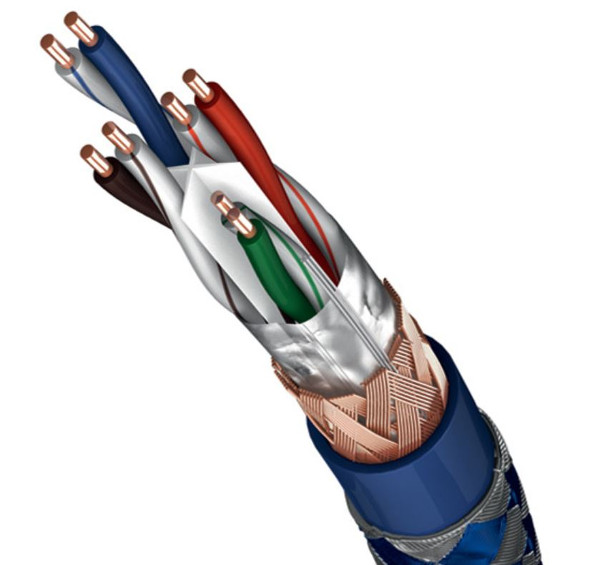
The Supra was a remarkable improvement over the OTSC. Orchestra was back and the music improved tonally and spatially. The Supra’s sound was darker, denser and more dynamic than that of the OTSC. Compared to the Vodka it lacked transparency and unfortunately preserved the boominess of the OTSC. The longer we listened to the Supra the more we missed a clearer view into what was the orchestra doing. Also the layering of the soundstage was not fine enough to appreciate it. Then came the Neyton.
With the Neyton left to right imaging became more precise and the instrumental mass was sorted out back to individual instruments. The tonal darkness of the Supra was replaced something of “resolved tunefulness”. We noticed that the Neyton sounded louder than the Supra; in fact it sounded louder than any other cable in the test. It was like the Neyton was compressing the thing a bit as crescendos and dynamic handwork of the cellist became flatter sounding. The compression – if it was a compression – helped the guitar of poprock tracks stand out and become more alive, so the Neyton’s sound was dependent on which track we were playing.
What we did not like about the Neyton’s Ethernet cable was the planarity of its soundstage – the music just happened on a canvas stretched between the speakers with a very limited depth. However, if you prefer detail over colour then the Neyton is a better choice than the Supra.
The Viablue cable feels very professional – it was delight to touch it and connect it for it is very flexible and its rugged connectors lock with a firm click. The Viablue had the immediacy of the Neyton to which it added the soundstage depth, the cello acquired body and the orchestra surrounded it. Dynamics were also much improved. The rolls of timpani, for example, had thunderous impact and improved definition, yet there was also a hint of roundness and sweetness to the tone. As if the Viablue cast a slightest touch of gold on everything, making recordings sound unforced, organic and flowing, not unlike vacuum-tube vibe or saturation of master tapes if you like. It was easy to listen to the Viablue for hour without feeling that something might be wrong. Quite opposite, the articulation of voices was mesmerizing through it.

The InAkustik topped the Neyton in resolution, taking it one level higher with clarity, focus and presence. Also it was a quick sounding cable that favored rhythmic pieces. Both aforementioned attributes have something to do with quite hot top end – some may be less tolerant to it than others as hot recordings sound nastier and good recordings benefit with extra sparkle and air. There is always a tradeoff – slight loss of grunt, body and image specificity in this case. Thus with Cello Abbey I preferred the Viablue to the InAkustik for its giving more flesh to bones. But it was the InAkustik that was more neutral and helped detect slight nasal coloration of the Viablue.
Re-inserting the AudioQuest Vodka into the system was revelation: it dug deeper, was exemplary balanced and natural sounding, and the soundstage opened up in all directions. The Vodka emphasized higher mids which helped vocal stand out and articulate better. It was also the most transparent cable in the test, by lightyears.
To wrap up, the Ethernet cables used for unpacketed voltage transfer behave the same way like any other analog cable and the differences between them are clearly audible. It is time to check how they behave in proper digital routing.
Playing the cables: A router cable
Walking on the thin ice of a technical theory that is considered bulletproof there should be zero difference between a stock patch cable and anything that is sold for the price of gold.
We used the Ethernet cables between Airport Express Router and Node2 16bit/44kHz, from where the signal was routed to Vincent DAC-1 D/A converter via Viablue coaxial cable. The speakers were Aurum Cantus V8F fed by Vincent SV-700 integrated amplifier.
Without beating around the bush it was really tough to audibly differentiate between the reviewed cables. We did the same exercise that we did at the beginning of the first round: the duel between the Vodka and the OTSC. Though we thought we could identify subtle variations in how they sounded, after swapping the cables several times we were not able to tell the difference between the two. As much as it was clear with the HS-Link application it became psycho with the digital routing. On top of everything the NODE2 has an internal buffer memory so it is not possible to pause the recording, unconnect one cable and reconnect another one because approximately 15 sec of “the sound” we hear is uploaded in the memory already. This way we had to reset the buffer before connecting each cable. At the end we settled on a random A-B-X blind test methodology and submit all the cables that we had to extensive comparison.
Not knowing which cable we were auditioning (the test pattern looked like A-B-A-A-A-B, for example), step by step some nuances in how the cables performed started to appear. When I say nuances I mean perhaps 1%, perhaps 5% of difference between the Ethernet cables that we used. Nothing to really write home about. Most cables performed about the same, there were only two that stood out. The Supra was audibly softer and more muffled than others, keeping similar signature that was heard in the HS-Link application. The OTSC became the winner of the test – it was the preferred cable even in the direct shootout with the AudioQuest, no matter how technically inferior it may be.
Conclusion
Although it may not be exactly what you want to hear, for the router/streamer connection please feel free to use any RJ-45 cable that is on hand. If you want to feel unique then invest a bit more into a product like Viablue, or dress a standard patch cable in a colourful jacket or shrinkwrap of your choice. What is puzzling is that in theory there should be zero difference between the cables and still there was some. It would be interesting to hear what some 30-40 meters of the cable between the router and NODE2 would do. We’ll leave it up to you to experiment.

(C) 2018 Audiodrom



